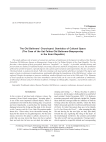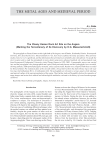Archaeology, Ethnology & Anthropology of Eurasia @journal-aeae-en
Статьи журнала - Archaeology, Ethnology & Anthropology of Eurasia
Все статьи: 524

The Aul-Koshkul-1 Cemetery in the Baraba Forest-Steppe: Findings of a Multidisciplinary Study
Статья научная
We present the results of aerial photographic and magnetometric studies at Aul-Koshkul-1, a group of mounds in the Baraba forest-steppe. Photogrammetry proved highly efficient for constructing orthophotographic plans and digital models of outward features at archaeological sites. Data were processed with an original approach, generating a map of relative heights, decreasing the effect of natural relief and highlighting altitudinal anomalies of an anthropogenic origin. Aerial photography is highly efficient for revealing archaeological features that are hard to locate by visual analysis of the surface (mounds destroyed by tillage, shallow ditches, etc.). Orthophotographic plans constructed by aerial photography in oblique sun rays at sunset present the most contrastive representations. Aerial magnetometry revealed most mounds at Aul-Koshkul-1, although the site was surveyed with minimal accuracy because magnetic anomalies caused by archaeological features were rare. Our multidisciplinary study yielded new information about the mounds previously registered by ground-based magnetometry, and discovered new features, leading to a revision of the cemetery’s reconstructed boundaries and composition. The study demonstrates the great potential of a joint use of aerial magnetometry and aerial photography for locating and studying archaeological sites at a new, sophisticated level.
Бесплатно

The Chemical Analysis of Glass Samples from Roman Era Cemeteries in the Crimean Piedmont
Статья научная
We assessed the chemical composition of more than 40 fragments of glass vessels from the Roman Period cemeteries in the Crimean piedmont— Druzhnoe, Neyzats, and Opushki, using X-ray spectral microanalysis. The results suggest that the glass from all the cemeteries belonged to the soda-lime-silica group, based on natural soda. The samples fall in glass groups “Levantine I”, “HIMT”, and “Roman glass”, typical of central and peripheral Roman manufacture in 0–500 AD. Most vessels are made of glass with a high content of iron, manganese, and titanium, as in the HIMT group, most common in Europe since 300 AD. The likely workshops are those in the Syro-Palestinian area, northern Egypt, and Sinai, pointing to contacts of the northern Pontic with other parts of the Greco-Roman world. The composition of glass from all the three cemeteries is the same, suggesting that the sub-mountainous Crimea imported glassware from the same workshops.
Бесплатно

The Early Paleolithic Age site and the bifacial lithic industries of Southeast Asia
Статья
Бесплатно

The Jomon megalithic tradition in Japan: origins, features, and distribution
Статья обзорная
Бесплатно

The Kushevat site and the paleogeographic context of the initial peopling of Northern Urals
Статья научная
On the basis of new materials excavated in 2019–2021 from the Upper Paleolithic site of Kushevat, this study addresses the problem of initial human occupation of the Subpolar Urals. Geological and geomorphological fi ndings are presented along with new chronological and paleogeographical data. Archaeological and faunal materials are described, and result s of the traceological analysis of reindeer antlers with cut and chop marks are presented. The fi ndings suggest that Kushevat was a pioneer settlement of the northern Ob region. The obtained luminescence and radiocarbon ages suggest that the peopling of the Lower Ob region occurred prior to 30 ka BP. Climatic conditions during the fi rst half of the Upper Paleolithic (55–25 ka BP) were favorable for humans in the subpolar zone. Geological and geomorphological situation at the Upper Paleolithic sites of northwestern Urals (the Pechora and Kama basins) can be used as a paleogeographic analogue of the conditions in the Lower Ob region during the Pleistocene. The principal Upper Paleolithic sites in the region are associated with accumulations of megafaunal remains in the mouths of ancient gullies. Archaeological sites apparently consisted of two areas differing in location, economic specialization, and toolkit. Areas of the fi rst type include residential zones on leveled areas of the second river terraces adjacent to the ravines. Those of the second type are estuarine zones of modern valleys of streams and rivers, where huge accumulations of megafaunal remains are preserved at the bottoms of ancient ravines.
Бесплатно

Статья научная
This study deals with the concept of «cultural heritage» in the Kyrgyz Republic, including both material culture and traditional ideology. We describe their codification, and strategies for their preservation and popularization. We draw on a large database, which includes findings of original fieldwork. We outline the elaboration of the concept of cultural heritage and its content, presenting a systematic description of institutional aspect and meaning, and we analyze the practices of its implementation. The historical and cultural heritage is viewed as a multifactorial space. The realities of modern Kyrgyzstan suggest that the nation implements integration strategies in foreign policy. While using the notions of cultural heritage and traditional values, the republic strengthens its ties with other members of the CIS, raising the level of its integration into the Central Asian community and maintaining its status as part of the world civilization. Cultural heritage is a key resource of social change and the economic stabilization of local communities. Its preservation at the level of everyday culture, academic, and educational practices, museums, festivals, etc. is a condition of national consolidation.
Бесплатно

The Marfa kurgan in the Stavropol territory: an example of an ancient architectural structure
Статья обзорная
Бесплатно

The Nagaybaks: from social stratum to ethnic group (the origins of ethnic identity)
Статья обзорная
Бесплатно

Статья научная
This study addresses the structure of cemeteries and types of tombstones in the funerary tradition of the Russian Priestless Old Believers (known as Bespopovtsy) living in the Ust-Tsilma District of the Komi Republic. For the first time, a description of their graveyards, known as “mogilniki”, or “mogily”, is provided, and their history and preservation are outlined. Traditional beliefs concerning cemeteries and their arrangement are cited. The symbolism of the forms of tomb structures, reproducing not only canonical prescriptions and requirements, but also certain pre-Christian beliefs, is analyzed in detail. Folk terms relating to the dead and the afterlife are included. The degree and nature of post-revolutionary transformations, profoundly affecting the foundations of the Old Believers’culture, are explored. Despite the attempts to preserve traditions, modern lifestyles took root in the 1960s and 1970s. Elements of local specificity in funerary rites have nonetheless survived and can be seen in the symbolism of tombstones, synthesizing Christian and pre-Christian traditions. Findings of ethnographic, linguistic, and archival studies are presented.
Бесплатно

Статья научная
Archaeological fi ndings suggest that the Pazyryk burial chambers made from larch logs replicated dwellings, being a key symbol of culture. Log structures were built on both winter and summer pastures. Parts of them were placed in graves as substitutes for entire houses. Their inner structure corresponded to that of the house. All artifacts in the graves had been used in everyday life, being intrinsically related to the owners’ earthly existence. Felt artifacts functioned in the same way in elite burials and in those of the ordinary community members, although their quality was different. Felt carpets decorating the walls of the Pazyryk leaders’ houses were true works of art, while those found in ordinary burials were simple and rather crude. The typical form of the late 7th–3rd century BC wooden burial chambers in the Altai-Sayan was pyramidal. In the Southern Altai, this form survived until the 1800s–early 1900s in Telengit aboveground burial structures.
Бесплатно

Статья научная
The petroglyphs at Pisany Kamen on the right bank of the Angara, near Klimino, Kezhemsky District, Krasnoyarsk Territory, fi rst described by D.G. Messerschmidt in 1725, have been examined by many specialists. Most previous studies, however, were superfi cial, and the information they provided was unreliable and contradictory. To specify the site's location and to study the petroglyphs in more detail, using more advanced methods, the archaeological team from Krasnoyarsk Pedagogical University visited Pisany Kamen in 1999–2000. A topographic survey was carried out, and the petroglyphs were photographed and copied. Both previously known and new petroglyphs were recorded, showing animals, anthropomorphic fi gures in masks, and a separate mask. Results were compared with those recorded by Messerschmidt. The estimated dates of the site fall within a broad interval from the Early Bronze Age to the Late Iron Age (2nd millennium BC to 1st millennium AD). The pe troglyphs are relevant to various aspects of the ideology and material culture of the ancient popula tion of the region. Their further study will hopefully disclose the semantics of many images and assess their cultural and chronological attribution, relevant to the history of several modern groups of Siberia.
Бесплатно

The Russian Archaeological Project in South America: Principal Findings and Prospects
Статья научная
This study outlines the findings of field and laboratory studies by the first Russian archaeological expedition to South America in 2014–2015 and 2017–2018 in collaboration with colleagues from Ecuador and Japan. The project focused on sites of the Archaic (10.8–6.6 ka BP) and Early Formative period (5.5–3.5 ka BP) in the coastal zone of Santa Elena Province, Ecuador. Excavations at Real Alto (Valdivia culture) and Loma Alto (Las Vegas culture) yielded representative archaeological, anthropological, and faunal samples and a large series of AMS dates, providing a basis for a number of novel proposals regarding the chronology and periodization of cultures, their origin, and early pottery-production in South America. Specifically, we have demonstrated that at the very beginning of the Formative period, two early ceramic traditions coexisted—Valdivia and “San Pedro”. We have demonstrated the peculiarity of the “Tropical package” in the stone toolkit, and traced the previously unknown features of the funerary rites of the Las Vegas and Valdivia cultures. Radiocarbon analysis helped to correct the chronology of the late stage of the pre-ceramic Las Vegas culture (8.0–4.8 ka BP) and to estimate the tentative date of the earliest pottery manufacture at 4.8–4.7 ka BP. In conclusion, we outline the top priorities and prospects of Russian archaeological studies on the Pacific coast of South America, underscoring the importance of international cooperation.
Бесплатно

The Russian pioneers' winter camp on Karachinsky island, the Lower Tobol river, Western Siberia
Статья научная
In 2014, an expeditionfrom Tyumen State University excavated an underground dwelling on Karachinslqt Island, in the floodplain of the Tbbol, to check the chronicle data saying that Yermqk qnd his Cossacks had spent q winter at that place during their Siberian campaign. The log structure, measuring I0 m by 5 m by 2 m, consisted of two rooms. Three or four bottom tiers of logs have been preserved. Remains of a cellar were found in the central part east of the oven. The building existed for a short time because the area around it was sterile. Lenses of calcination and charcoal, and traces of fire on the logs of the structure suggest that it had burnt down. Then it was repaired, but the amount of garbage and kitchen waste is small. All household effects were carried out before the dwellers left. Finds include pottery, a grindstone, a potter s scraper, and pieces of slag and metal. An AMS date of the wood, generated at Arizona University, falls within the 17th century. The chemical analysis of background and old soils indicates intense use of the islandfor pqsture and manufacture. In sum, our survey provides no evidence of Yermak's stay on the island during his campaign. According to R.G. Skrynnikov, the Cossacks marchedfrom the Stroganov forts to the Siberian Khanate capital without wintering, which was tactically correct, since the Thtar forces were weak and fragmented because of Mametkul's foray into the Ural towns.
Бесплатно








